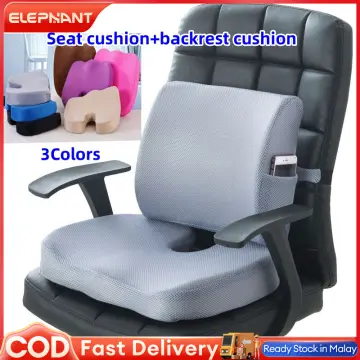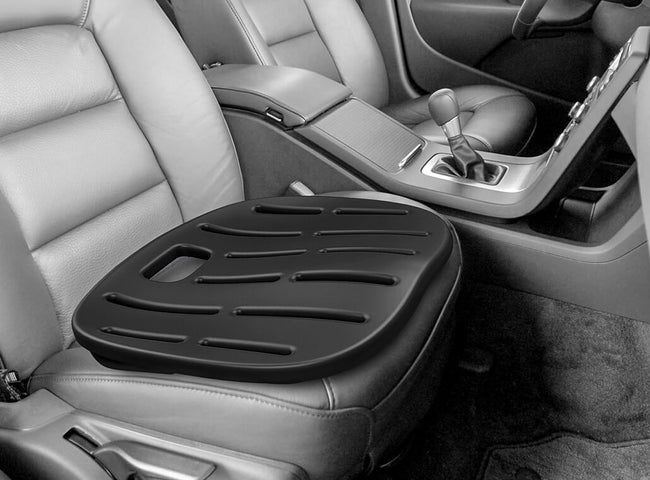Cushions for Back Pain in Car A Comprehensive Guide
Back pain is a common problem that can significantly impact our daily lives and affect our ability to work, socialize, and enjoy our hobbies. For car drivers, back pain can be particularly problematic, causing discomfort, pain, and stiffness after even short drives. Fortunately, cushions designed specifically for back pain can provide much-needed relief and support, allowing individuals to drive comfortably and pain-free. In this comprehensive guide, we will delve into the various types of cushions available for back pain in the car, their benefits, and key features to consider when choosing the right cushion. We will also discuss how to properly use these cushions for optimal results and provide additional tips to help alleviate back pain while driving.
Types of Cushions for Back Pain in Car

There are various types of cushions designed to provide support and alleviate back pain while driving. Each type offers unique benefits depending on the individual's specific needs and preferences.
Lumbar Support Cushions
Lumbar support cushions are designed to fill the gap between the lower back and the car seat, providing additional support to the lumbar region. They help maintain the natural curvature of the spine, reduce pressure on the discs, and alleviate lower back pain.
Seat Cushions
Seat cushions offer support and cushioning for the entire seat, including the tailbone and thighs. They help distribute body weight evenly, reduce pressure points, and improve overall comfort while driving.
Full-Body Support Cushions
Full-body support cushions provide support from the lower back to the thighs, promoting proper alignment of the spine and reducing strain on the back muscles. They are ideal for individuals with chronic back pain or those who require extra support during long drives.
Coccyx Cushions
Coccyx cushions are designed to relieve pressure on the tailbone, making them ideal for individuals with coccydynia or tailbone pain. They help reduce discomfort and promote proper posture while sitting in the car.
Cooling Gel Cushions
Cooling gel cushions use gel-infused memory foam to provide support and comfort while helping regulate body temperature. They are ideal for individuals who experience back pain exacerbated by heat or humidity.
Benefits of Using Cushions for Back Pain in Car

Using cushions for back pain in the car offers a wide range of benefits, including:
- Pain Relief: cushions provide support to the spine, reduce pressure on the discs, and alleviate back pain, allowing for a more comfortable driving experience.
- Improved Posture: The ergonomic design of cushions helps promote proper spinal alignment and reduces slouching, which can lead to improved posture over time.
- Enhanced Comfort: cushions offer additional padding and support, reducing pressure points and enhancing overall comfort during long drives.
- Reduced Fatigue: By providing support to the back, cushions help reduce muscle fatigue and stiffness, allowing for a more relaxed and enjoyable driving experience.
- Customized Support: There are various types of cushions available to suit different needs and preferences, allowing individuals to find the perfect fit for their specific back pain issues.
Key Features to Consider When Choosing a Cushion

When selecting a cushion for back pain in the car, there are several key features to keep in mind to ensure optimal comfort and support:
- Material: Choose a cushion made from high-quality, durable materials that provide adequate support and comfort. Memory foam, gel-infused foam, and breathable fabrics are popular choices.
- Design: Look for a cushion with an ergonomic design that promotes proper spinal alignment and reduces pressure on the back muscles. Contoured shapes and supportive padding are essential features to consider.
- Size and Fit: Ensure that the cushion fits your car seat properly and provides support to the areas where you need it most, such as the lumbar region, tailbone, or thighs.
- Portability: If you frequently switch between different vehicles or need to use the cushion outside of the car, consider a portable option that is lightweight and easy to carry.
- Maintenance: Opt for a cushion with a removable, machine-washable cover for easy cleaning and maintenance, ensuring that your cushion stays fresh and hygienic.
How to Properly Use Cushions for Back Pain in Car

To maximize the benefits of using cushions for back pain in the car, follow these tips for proper usage:
- Positioning: Place the cushion in the desired location on the car seat, ensuring that it provides support to the areas of the back that need it most, such as the lower back or tailbone.
- Adjustment: Experiment with different positions and angles to find the most comfortable and supportive setup for your unique needs. Make adjustments as needed during your drive.
- Regular Use: Use the cushion consistently during all your car journeys to maintain proper spinal alignment, reduce pressure on the back, and prevent discomfort and pain.
- Combine with Breaks: Take regular breaks during long drives to stretch, move around, and give your back a rest. Use the cushion in conjunction with good driving ergonomics for optimal results.
- Consult a Professional: If you have chronic back pain or underlying medical conditions, consult with a healthcare provider or physical therapist to determine the best cushion and usage for your specific needs.
Additional Tips to Alleviate Back Pain While Driving

In addition to using cushions for back pain in the car, consider incorporating the following tips into your driving routine to help alleviate back pain and discomfort:
- Adjust Your Seat: Position your car seat at the correct height and distance from the steering wheel to promote good posture and reduce strain on the back muscles.
- Use a Lumbar Roll: If your car seat does not provide adequate lumbar support, consider using a separate lumbar roll to fill the gap and support your lower back.
- Stay Hydrated: Drink plenty of water before and during your drive to stay hydrated, maintain spinal flexibility, and reduce the risk of muscle cramps.
- Stretch Regularly: Perform simple stretches for the neck, shoulders, and back during rest stops to release tension, improve circulation, and prevent stiffness.
- Mind Your Driving Posture: Sit upright with your back against the seat, shoulders relaxed, and hands at the proper position on the steering wheel to minimize strain on the back muscles.
By incorporating these tips and using cushions designed for back pain in the car, you can create a more comfortable, ergonomic driving environment that supports your back health and overall well-being.
In conclusion, cushions for back pain in the car are valuable tools that can help alleviate discomfort, promote proper spinal alignment, and enhance overall driving comfort. By choosing the right type of cushion, considering key features, and using them correctly, individuals can effectively manage back pain and enjoy pain-free journeys behind the wheel. Remember to prioritize your back health, practice good driving ergonomics, and seek professional guidance if needed to ensure a safe and comfortable driving experience.
Headache due to Low Blood Pressure
Headaches are a common symptom experienced by individuals with low blood pressure, also known as hypotension. When the blood pressure drops below normal levels, it can lead to inadequate blood flow to the brain, resulting in various symptoms, including headaches. Understanding the relationship between low blood pressure and headaches is essential for proper management and treatment.
Causes of Headaches Due to Low Blood Pressure
- Decreased Blood Flow: Low blood pressure reduces the amount of blood flowing to the brain, leading to decreased oxygen and nutrient supply. This insufficient blood flow can trigger headaches as the brain struggles to function optimally.
- Hypotensive Episodes: Sudden drops in blood pressure, known as hypotensive episodes, can cause a rapid onset of headaches. These episodes may occur when transitioning from lying down to standing up quickly, leading to a temporary decrease in blood flow to the brain.
- Vasodilation: Low blood pressure can result in vasodilation, where blood vessels in the brain widen to compensate for the reduced pressure. This vascular response can contribute to throbbing headaches due to increased blood vessel size and altered blood flow patterns.
Managing Headaches Associated with Low Blood Pressure
Individuals experiencing headaches due to low blood pressure can implement various strategies to manage their symptoms effectively:
- Stay Hydrated: Adequate hydration is crucial for maintaining blood volume and supporting healthy blood pressure levels. Drinking sufficient water can help prevent dehydration, a common cause of low blood pressure and associated headaches.
- Gradual Changes in Position: To minimize the risk of hypotensive episodes and subsequent headaches, avoid sudden movements that can lead to rapid drops in blood pressure. Slowly transition from lying down to sitting and then standing to allow your body to adjust.
- Balanced Diet: Consuming a nutritious diet rich in electrolytes, such as potassium and sodium, can support healthy blood pressure regulation. Including foods like bananas, leafy greens, and nuts in your meals can help stabilize blood pressure levels and reduce headache frequency.
By addressing the underlying causes of low blood pressure and adopting lifestyle modifications to support cardiovascular health, individuals can effectively manage headaches associated with hypotension.
Headaches: An Introspection into Brain Metabolism
Headaches are often attributed to changes in brain metabolism, highlighting the intricate relationship between metabolic processes and pain perception. Understanding how alterations in brain metabolism can contribute to headaches is essential for developing targeted treatment approaches and improving patient outcomes.
Metabolic Factors Influencing Headache Development
- Cerebral Blood Flow: Metabolism in the brain relies heavily on adequate cerebral blood flow to deliver oxygen and nutrients essential for energy production. Disruptions in blood flow dynamics can lead to metabolic imbalances and trigger headache episodes.
- Neurotransmitter Activity: Metabolic pathways involved in neurotransmitter synthesis and release play a significant role in modulating pain signaling within the brain. Imbalances in neurotransmitter levels, such as serotonin and dopamine, can influence headache severity and duration.
- Mitochondrial Function: Mitochondria, the powerhouse of cells, are critical for generating energy through oxidative phosphorylation. Impaired mitochondrial function can compromise energy production in the brain, contributing to metabolic stress and potentially triggering headaches.
Therapeutic Approaches Targeting Brain Metabolism for Headache Relief
- Nutritional Support: A balanced diet rich in antioxidants, vitamins, and minerals can promote optimal brain metabolism and reduce oxidative stress, a common trigger for headaches. Incorporating foods that support mitochondrial function, such as avocados and fatty fish, can enhance energy production and alleviate headaches.
- Hydration: Proper hydration is essential for maintaining metabolic homeostasis in the brain. Dehydration can impair cerebral blood flow and hinder metabolic processes, increasing the likelihood of developing headaches. Drinking an adequate amount of water daily is crucial for headache prevention.
- Physical Activity: Regular exercise has been shown to improve brain metabolism by enhancing blood flow, neurotransmitter release, and mitochondrial biogenesis. Engaging in physical activity can boost energy levels, reduce stress, and alleviate headache symptoms by promoting healthy metabolic function.
By exploring the intricate connection between brain metabolism and headache pathophysiology, healthcare providers can tailor treatment strategies that address underlying metabolic disturbances and provide effective relief for individuals suffering from chronic headaches.
In conclusion, headaches associated with low blood pressure and alterations in brain metabolism highlight the critical role of metabolic factors in pain perception and headache development. By addressing the underlying metabolic imbalances through lifestyle modifications, nutritional interventions, and targeted therapies, individuals can experience relief from headaches and improve their overall quality of life. It is essential to consult healthcare professionals for comprehensive evaluation and personalized treatment plans to effectively manage headaches and optimize brain metabolism for long-term wellness.



